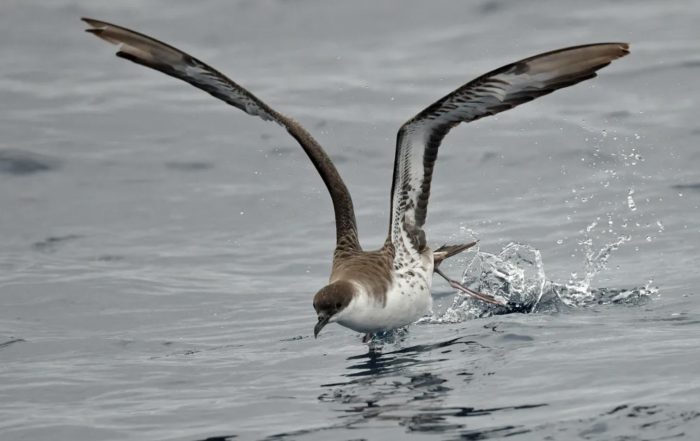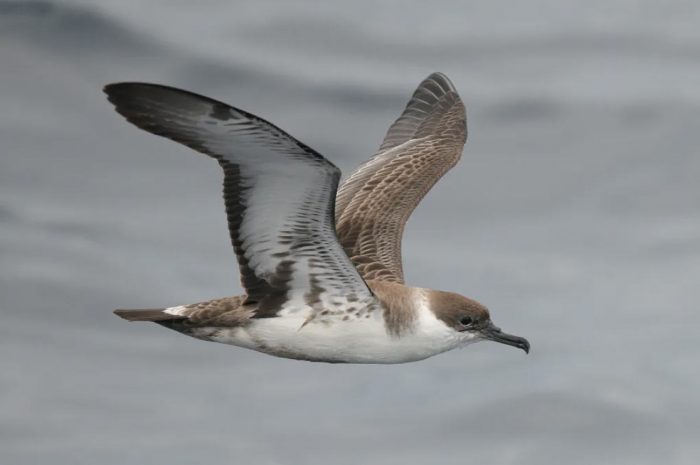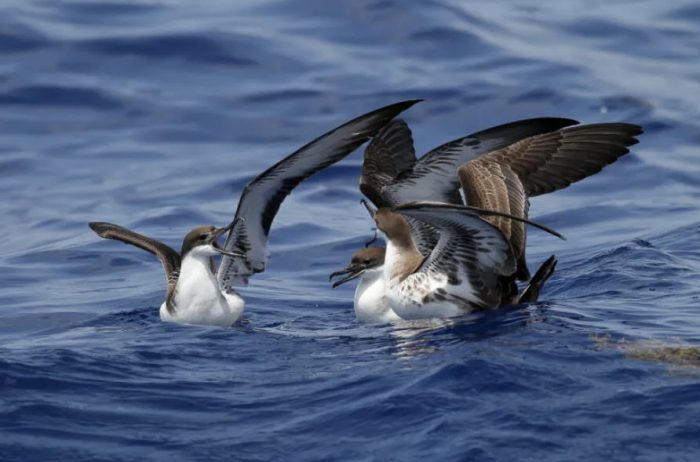
When you talk about amazing animals, consider adding the Great Shearwater to the mix. They can fly between waves of 40 feet or higher in hurricane-like weather.
Large seabirds — 20 inches in length with a 3.5- to 4-foot wingspan – they get their name from their ability to navigate between swells, seemingly cutting, or “shearing,” the water.
The Great Shearwater feeds primarily on fish such as mackerel, sand lance, and capelin, also squid and crustaceans that swim near surface of the water. They forage by catching prey from the surface and by plunge-diving, sometimes as deep as 55 feet.
Possessing an extraordinary sense of smell, they will follow trawlers, sometimes in considerable numbers, awaiting cast off fish offal.
They have a piercing “eeyah” cry usually given when resting in groups on the water.
In the early 19th Century, John James Audubon portrayed this species as the Wandering Shearwater, another apt name.
Many aspects of the biology of these seagoing birds remain a mystery. The average longevity is not very well known, with some estimates are at seven years. But one individual was believed to be more than 50 years old —gaining the status of an ancient mariner.
In the early 19th Century, John James Audubon portrayed this species (Ardenna gravis) as the Wandering Shearwater, another apt name.
Worldwide there are 32 shearwater species with five species that can be seen in the Gulf Stream waters off North Carolina The state’s other regularly occurring species are Audubon’s Shearwater, Cory’s Shearwater, Manx Shearwater and Sooty Shearwater. Two others, the Wedge-tailed Shearwater, and Cape Verde Shearwater, are extremely rare with just one documented record each.
Numbers and frequency of sightings of sea birds off North Carolina primarily rely on data gathered by Brian Patteson who has been running pelagic birding field trips since 1986. His business, Seabirding, runs these trips out of Hatteras to the Gulf Stream. Great Shearwaters may be seen from June to early November with the highest numbers from late July through August.
Based on time of the year, strong easterly wind conditions and available prey, it is possible to see these shearwaters from the shores of the Outer Banks, with three hot spots: Jeanette’s Pier in Nags Head, Oregon Inlet and Cape Point on Hatteras Island.
Unlike the other shearwater species in our waters, Great Shearwaters are subject to mass mortalities as what occurred in late June into early July this year. The Cape Hatteras and Cape Lookout National Seashores confirmed seeing many dead or dying individuals on the beach. The Wilmington Star News reported a remarkably high number of shearwaters picked up from the beaches of Brunswick County and brought to the Sea Biscuit Wildlife Shelter, a wild bird rehabilitation center located on Oak Island.

Staff of the NC Wildlife Resource Commission gathered about 100 dead birds and sent them to Southeastern Cooperative Wildlife Disease Study (SCWDS). A final report has not been released,.
These high mortalities occurred around the time of some sustained bad weather with tumultuous seas.
Die-offs like this may be from an avian disease or consuming toxins, but often the cause is starvation due to food shortages or an inability to forage, according to a study by North Carolina biologist David S. Lee in 2014.
The National Park Service did not perform any necropsies to determine the cause of death but did confirm that many of them appeared to be younger birds, looking thin and were lethargic.
“While we don’t know the exact cause of the shearwaters washing ashore in June, we do know that natural variables, such as weather and food shortages, play a large role in their survival,” an official wrote.
Kate Sutherland, Patteson’s lead guide and record keeper, has been working with Seabirding since 2001. Not only is she an expert on Atlantic seabirds, she is also a superb photographer.
She agrees with the starvation theory. “We are one of the first places they can feed during migration, and they are on the brink of starvation,” noting how hungry they appear on their arrival.
“Mortality in the first year is high as with most species. But some years the weather brings them to our beaches instead of keeping them at sea,” she wrote. “I imagine there are other factors that could be exacerbating their death rate as seas warm and weather changes, plus plastic…there is so much more every year and that has to impact them if they are ingesting it on their journey.”
Sutherland noted the vivacity of these birds.
“They are one of the most charismatic followers on our trips because they come right to the boat to eat the chum, diving and calling and fighting!”
As sad as this is to see, such kill-offs do not impact the overall world population. According to Cornell University’s Birds of the World, it is estimated that there may be as many as 15 million individuals.

Tristan da Cunha archipelago
After roaming throughout much of the northeastern Atlantic Ocean as far north to Newfoundland, they head to the southwestern coasts of Great Britain and Ireland. In September, they begin their southern migration to their nesting grounds, one of the remotest places in the world.
Aside from a small nesting colony on Kidney Island in the Falklands, the other known breeding locations are on the volcanic Tristan da Cunha archipelago smack in the middle of the South Atlantic Ocean and 6,500 miles from North Carolina. It is a British Overseas Territory that also has nesting Northern Rockhopper Penguins, Atlantic Yellow-nosed Albatrosses, Sooty Albatrosses, Atlantic Petrels, Great-winged Petrels, Soft-plumaged Petrels, Broad-billed Prions, Grey Petrels, Sooty Shearwaters, Tristan skuas, Antarctic Terns and Brown Noddies.

The Great Shearwater numbers are staggering, with 5 million breeding pairs on the largest island, Tristan da Cunha, followed by Nightingale Island with 2 to 3 million pairs, two million on Inaccessible Island and the distant Gough Island has estimates of up to 3 million pairs.
Shearwaters nest in crevices between rocks or a three-foot deep burrow, excavated by both parents, that may be used for several years and lay just one egg. Incubation takes approximately two months and both parents participate in feeding, returning only in the dark to avoid one of their diurnal predators, South Polar Skuas. Fledging takes nearly four months.
How remote are these islands? There are no airstrips, so the only way of travelling to them is by boat. The fastest is a six-day trip from South Africa. Only 250 people live on the biggest island, Tristan da Cunha. The rest are uninhabited.
Notes
If you thumb through an older bird field guide, you will not find the Great Shearwater. In 2010, the American Ornithologists’ Union changed the common name of Greater Shearwater to Great Shearwater, matching the common name used in Europe, and making more “sense”, as there is no “Lesser Shearwater,” though there is a Little Shearwater.
Not surprisingly, aside from the mass mortalities described above, necropsies performed on these shearwaters and other pelagic birds are finding high levels of plastic ingestion.
The Stellwagen Bank, located off the Massachusetts coast between Cape Cod and Cape Ann, is a National Marine Sanctuary managed by NOAA and where Great Shearwaters congregate in large numbers in late Summer.
Since 2013, researchers there have been using satellite technology to study their movements, life cycle, and feeding and foraging habits.
In 2021, state-of-the-art transmitters, small, lightweight, and equipped with mini solar panels were attached to 15 birds to track the birds’ migratory paths into the South Atlantic. You can follow their movements here: https://twitter.com/trackseabirds or by the Twitter handle @trackseabirds.
Great Shearwaters were chosen for this tracking project because they are considered to be excellent indicators of ecosystem health and may provide insights into impacts of climate change.




